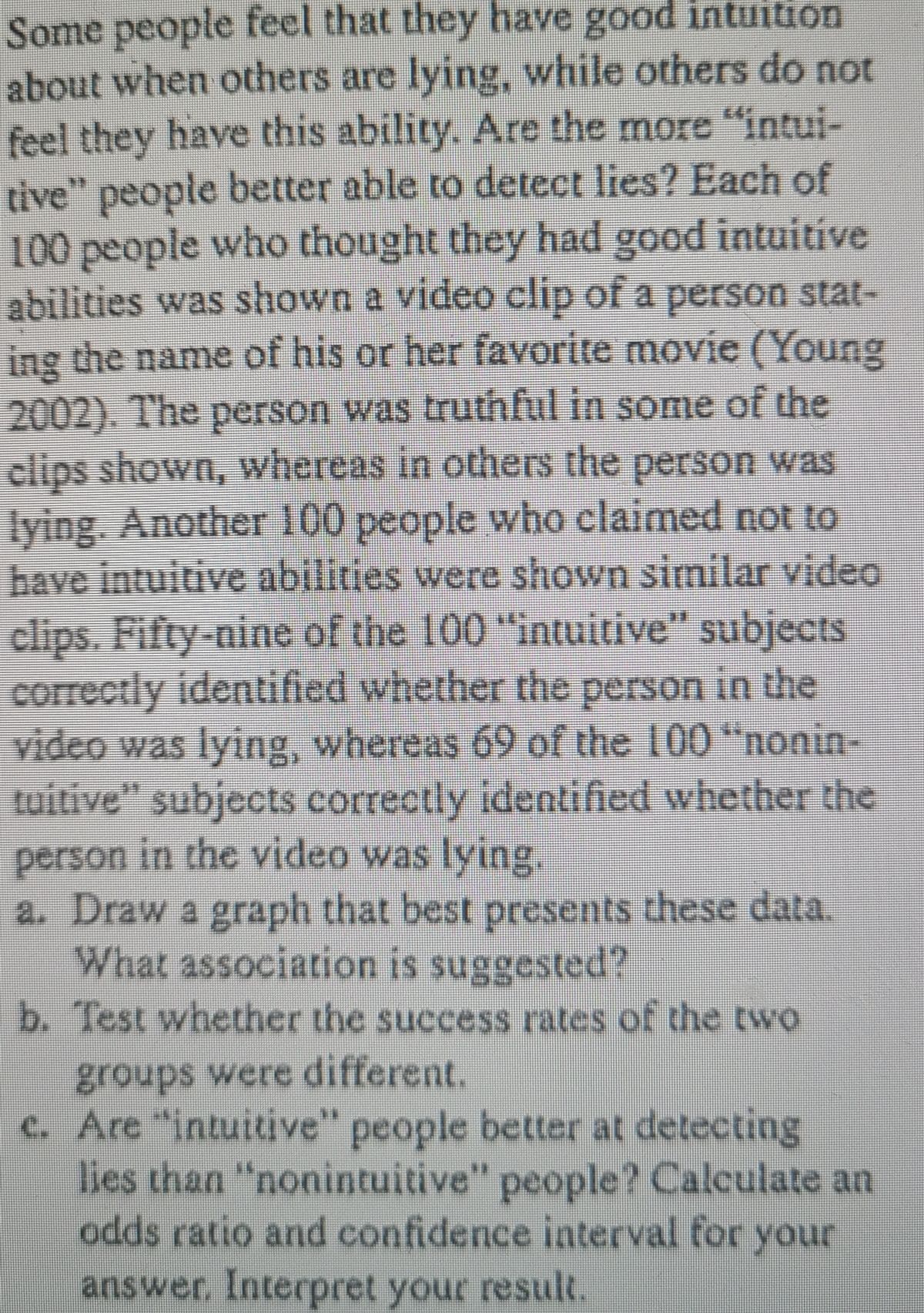Some people feel that they have good intuition about when others are lying, while others do not feel they have this ability. Are the more "intui- tive" people better able to detect lies? Each of 100 people who thought they had good intuitive abilities was shown a video clip of a person stat- ing the name of his or her favorite movie (Young 2002). The person was truthful in some of the clips shown, whereas in others the person was lying. Another 100 people who claimed not to bave intuitive abilities were shown similar video clips. Fifty-nine of the 100 "intuitive" subjects correctly identified whether the person in the video was lying, whereas 69 of the 100 "nonin- tuitive" subjects correctly identified whether the person in the video was lying. a. Draw a graph that best presents these data. What association is suggested? b. Test whether the success rates of the two groups were different. c. Are "intuitive" people better at detecting lies than "nonintuitive" people? Calculate an odds ratio and confidence interval for your answer, Interpret your result.
Some people feel that they have good intuition about when others are lying, while others do not feel they have this ability. Are the more "intui- tive" people better able to detect lies? Each of 100 people who thought they had good intuitive abilities was shown a video clip of a person stat- ing the name of his or her favorite movie (Young 2002). The person was truthful in some of the clips shown, whereas in others the person was lying. Another 100 people who claimed not to bave intuitive abilities were shown similar video clips. Fifty-nine of the 100 "intuitive" subjects correctly identified whether the person in the video was lying, whereas 69 of the 100 "nonin- tuitive" subjects correctly identified whether the person in the video was lying. a. Draw a graph that best presents these data. What association is suggested? b. Test whether the success rates of the two groups were different. c. Are "intuitive" people better at detecting lies than "nonintuitive" people? Calculate an odds ratio and confidence interval for your answer, Interpret your result.
Glencoe Algebra 1, Student Edition, 9780079039897, 0079039898, 2018
18th Edition
ISBN:9780079039897
Author:Carter
Publisher:Carter
Chapter10: Statistics
Section10.6: Summarizing Categorical Data
Problem 13CYU
Related questions
Question

Transcribed Image Text:Some people feel that they have good intuition
about when others are lying, while others do not
feel they have this ability. Are the more "intui-
tive" people better able to detect lies? Each of
100 people who thought they had good intuitive
abilities was shown a video clip of a person stat-
ing the name of his or her favorite movie (Young
2002). The person was truthful in some of the
clips shown, whereas in others the person was
lying. Another 100 people who claimed not to
bave intuitive abilities were shown similar video
clips. Fifty-nine of the 100 "intuitive" subjects
correctly identified whether the person in the
video was lying, whereas 69 of the 100 "nonin-
tuitive" subjects correctly identified whether the
person in the video was lying.
a. Draw a graph that best presents these data.
What association is suggested?
b. Test whether the success rates of the two
groups were different.
c. Are "intuitive" people better at detecting
lies than "nonintuitive" people? Calculate an
odds ratio and confidence interval for your
answer, Interpret your result.
Expert Solution
This question has been solved!
Explore an expertly crafted, step-by-step solution for a thorough understanding of key concepts.
Step by step
Solved in 4 steps with 1 images

Recommended textbooks for you

Glencoe Algebra 1, Student Edition, 9780079039897…
Algebra
ISBN:
9780079039897
Author:
Carter
Publisher:
McGraw Hill

Algebra: Structure And Method, Book 1
Algebra
ISBN:
9780395977224
Author:
Richard G. Brown, Mary P. Dolciani, Robert H. Sorgenfrey, William L. Cole
Publisher:
McDougal Littell

College Algebra (MindTap Course List)
Algebra
ISBN:
9781305652231
Author:
R. David Gustafson, Jeff Hughes
Publisher:
Cengage Learning

Glencoe Algebra 1, Student Edition, 9780079039897…
Algebra
ISBN:
9780079039897
Author:
Carter
Publisher:
McGraw Hill

Algebra: Structure And Method, Book 1
Algebra
ISBN:
9780395977224
Author:
Richard G. Brown, Mary P. Dolciani, Robert H. Sorgenfrey, William L. Cole
Publisher:
McDougal Littell

College Algebra (MindTap Course List)
Algebra
ISBN:
9781305652231
Author:
R. David Gustafson, Jeff Hughes
Publisher:
Cengage Learning